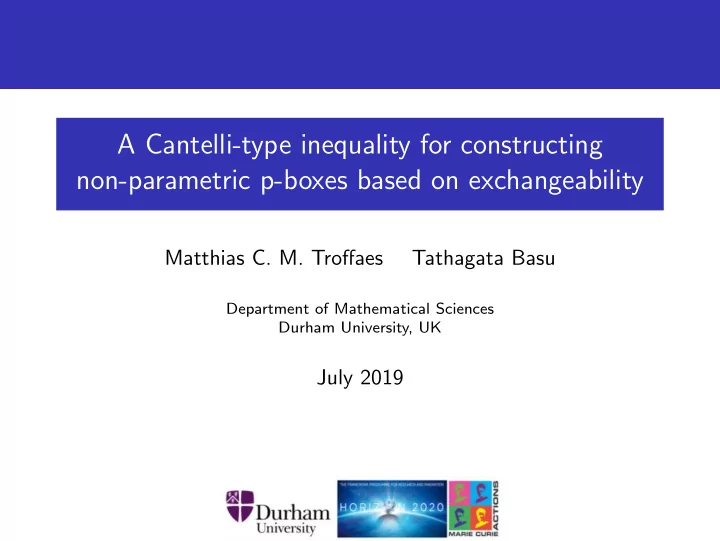

A Cantelli-type inequality for constructing non-parametric p-boxes based on exchangeability Matthias C. M. Troffaes Tathagata Basu Department of Mathematical Sciences Durham University, UK July 2019
Outline 1 Cantelli’s inequality and p-boxes 2 Contributions 3 Conclusions
Cantelli’s inequality & induced p-box • random variable X , known mean µ and variance σ 2 • Cantelli’s inequality [1]: � X − µ � 1 0 ≤ P ≤ λ ≤ if λ ≤ 0 , (1a) 1 + λ 2 σ λ 2 � X − µ � 1 + λ 2 ≤ P ≤ λ ≤ 1 if λ ≤ 0 . (1b) σ • induces a p-box (lower & upper cdf, bounding a set of probability measures) Issue What if only sample mean and sample standard deviation are known?
Contributions: Problem Statement Assumptions X 1 ,. . . , X n , X n +1 is a finite sequence of discrete exchangeable random variables. Notation � n j =1 ( X j − X ) 2 • S 2 := � n • X := 1 j =1 X j n ( n − 1) Objective Find functions f and f such that � X n +1 − X � f ( λ, n ) ≤ P ≤ λ ≤ f ( λ, n ) (2) S
Contributions: Cantelli-type inequality Theorem For every λ ≥ 0 , � � � ( n + 1) λ 2 � 1 X n +1 − X n ≤ P < λ ≤ 1 (3) λ 2 S + ∆ n n + 1 n + 1 √ n � n n +1 where λ n := n 2 − 1 λ and ∆ n := n − 1 (max X j − min X j ) . √ Similarly, for every λ ≤ 0 , � n + 1 � � X n +1 − X 1 � 0 ≤ P ≤ λ ≤ . (4) S + ∆ n λ 2 n + 1 n + 1 √ n Here, ⌊ x ⌋ := max { n ∈ Z : n ≤ x } and ⌈ x ⌉ := −⌊− x ⌋ .
Contributions: Cantelli-type inequality Plotting left and right hand sides from inequalities in theorem:
Contributions: P-box and Prediction Interval Inequalities from theorem induce the following: Non-parametric p-box . . . on the random variable Z n +1 = X n +1 − X . S + ∆ n √ n Not a p-box on X n +1 directly! Prediction interval . . . on the random variable X n +1 . For any ℓ 1 and ℓ 2 , we can calculate α 1 and α 2 such that α 1 ≤ P ( X − ℓ 1 S n < X n +1 ≤ X + ℓ 2 S n ) ≤ α 2 (5) where, S n := S + ∆ n √ n .
Conclusions I • novel Cantelli-type inequality • induces non-parametric p-box and prediction interval • only assumes exchangeability (rather than conditional independence) • only uses sample mean and sample standard deviation • similar to Saw [2] (but Saw does not induce a p-box) • useful for modelling when only sample mean and sample standard deviation are known (e.g. measurement problems)
Conclusions II • p-box only on Z n +1 and not on X n +1 • use of prediction interval not entirely clear • p-box on X n +1 , conditional on X and S , using exchangeability, remains and open problem (might be impossible as pointed out by a kind reviewer)
Thank you for your attention! We look forward to seeing you at our poster!
References F. P. Cantelli. “Sui confini della probabilit` a”. In: Atti del Congresso Internazional del Matematici 6 (1928). Bologna, pp. 47–59. John G. Saw, Mark C. K. Yang, and Tse Chin Mo. “Chebyshev Inequality with Estimated Mean and Variance”. In: The American Statistician 38.2 (1984), pp. 130–132.
Recommend
More recommend